
The concept of Quality Control & Asset Integrity Management came into existence during the first industrial revolution. Up until the early 1920’s the major focus was quantity over quality. It was only when we entered the 20th century that the focus shifted to the latter.
Why Digitization is Necessary?
Catastrophes caused due to submersed asset failures in sectors such as Maritime, Infrastructure, Energy & Power have become a major concern in recent years. Even a single failure can have a huge impact on the continuity of the business. In addition to that it can also cause loss of lives of the personnel on-site. In order to mitigate this issue, ROVs and novel underwater inspection techniques were invented. Inspections are essential to delivering optimal efficiency & safety. But they are tedious and cost a lot; hence it is not possible to inspect every single component of an underwater asset. There must be some form of priority-based or Risk-Based Inspection (RBI) to get accurate results and determine the frequency of inspections.
Digitization of Inspection Data is the solution to all these problems. Utilization of evolving systems of digitization and statistical analysis will allow the asset managers to view defects that would be impossible to locate without digital intervention. Underwater robotics & data digitization go hand in hand. There will be an on-site team that will deploy the ROV carrying payloads such as remote cameras, lasers & other advanced equipment. The Inspection data will then be analysed and consolidated in digital format. This information will then be passed on to the operational management who will take decisions to safeguard the integrity of the asset.
What are the Benefits of Digitized Underwater Inspection Data?
Damage Control:
Any asset manager’s primary aim is to ensure damage control. Building an up-to-date set of information is the best way to mitigate risk. A digital document will provide you with access to all crucial data such as precise defect location, type of defect, required measurements, material descriptions and much more. This will decrease the chances of rework and increase the accuracy of the work carried out on-site. In the long run, this lowers risks and helps the manager focus on other important matters.
Asset Condition Assessment:
Digitized Underwater Inspection data helps asset owners assess the condition of their assets as they are provided to you in an enhanced photo-realistic format. The cloud data can forecast the risks the structure may face, hence, helping the managers take a proactive approach.
Life-cycle Management:
Underwater infrastructure is built to last for decades or centuries, but to accomplish this their life cycle needs to be expertly managed. The needs of different phases must be addressed. Digitized Underwater Inspection data offers crucial reference points to compare new findings or to plan future enlargements.
Maintenance Planning:
Underwater structures tend to face extreme environmental stress. Underwater asset management calls for regular surveys to monitor the changes over time. Maintenance planning without proper knowledge can be arbitrary and expensive. Multibeam SONAR inspections and information-rich point cloud data makes sure that your structure’s maintenance plans can be calculated accurately in every stage of its life cycle.
Thus, we can conclude that Digitization of Underwater Inspection Data is indeed a highly beneficial, cost & time-efficient solution that can help asset managers in strategic decision making. To get to know more interesting facts about this phenomenon, get in touch with us at Planys. Write to us at sales@planystech.com or give us call on +91-8448188507


